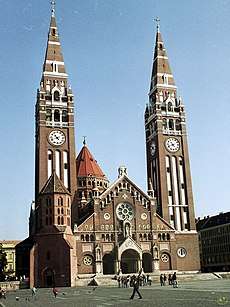Roman Catholic Diocese of Szeged–Csanád
The Roman Catholic Diocese of Szeged–Csanád (Latin: Dioecesis Szegediensis–Csanadiensis) is a diocese located in the cities of Szeged and Csanád in the Ecclesiastical province of Kalocsa-Kecskemét in Hungary.
Diocese of Szeged–Csanád Dioecesis Szegediensis–Csanadiensis Szeged-Csanádi egyházmegye | |
|---|---|
 The Cathedral of Our Lady of the Hungarians Szeged | |
| Location | |
| Country | Hungary |
| Ecclesiastical province | Kalocsa-Kecskemét |
| Metropolitan | Kalocsa-Kecskemét |
| Statistics | |
| Area | 10,851 km2 (4,190 sq mi) |
| Population - Total - Catholics | (as of 2014) 889,000 363,500 (40.9%) |
| Information | |
| Rite | Latin Rite |
| Cathedral | Cathedral of Our Lady of the Hungarians |
| Current leadership | |
| Pope | Francis |
| Bishop | László Kiss-Rigó |
| Metropolitan Archbishop | Balázs Bábel |
| Bishops emeritus | Endre Gyulay Bishop Emeritus |
| Map | |
 | |
| Website | |
| Website | |
The diocesan cathedral is the Cathedral of Our Lady of the Hungarians in Szeged. The Co-Cathedral of St. Anthony of Padua is based in Békéscsaba.
History
- 1035: Established as Diocese of Csanád
- August 5, 1982: Renamed as Diocese of Szeged – Csanád
List of bishops
- 1030–1046 St Gerard
- 1046–1053 Maurus
- 1053–1083 unknown
- 1083–1113 Lorenz
- fl. 1138 Besztréd
- fl. 1142 Pál
- 1156–1169 Stefan
- 1188–1192 Saul von Altenburg
- 1192–1193 Krispin
- 1198–1201 János I
- 1202–1229 Desiderius
- 1229–1242 Bulcsú Bölcs
- 1243–1257 Balázs
- 1259–1275 Bereczk
- 1275–1291 Gergely I
- 1298–1307 Antal I
- 1307–1332 Benedikt
- 1332–1343 Jakab Piancenzai
- 1343–1344 István II Harcsáki (Büki)
- 1344 Galhard de Carceribus
- 1345–1350 Gergely II Kapronczai
- 1350–1358 Tamás I Telegdi
- 1359–1360 Gergely III Lendvai (Fugyi)
- 1360–1373 Domonkos Bebek
- 1373–1375 Miklós I
- 1377–1379 Pál II Péterfia
- 1379–1380 Tamás II
- 1380–1386 János II Czudar
- 1386–1395 János III
- 1395–1397 Lukács I Órévi
- 1397–1402 Gergely IV Szeri Pósafi
- 1403–1423 Dózsa Marczalli
- 1423–1443 László I Marczalli
- 1434–1438 Albert I Kerolti
- 1438–1457 Péter I Remetei Himfi
- 1457–1466 Albert II Hangácsi
- 1466–1493 János IV Szokoli
- 1493–1500 Lukács II Szegedi Baratin
- 1500–1514 Miklós II Körösszegi Csáki
- 1514–1526 Ferenc I Csaholi
- 1526–1529 János V Musinai Gerván
- 1529–1537 János VI Bonzagnó
- 1537–1552 János VII Barlabássy
- 1553–1554 Ferenc II Medgyesi Székely
- 1556–1558 György I Bódy
- 1559–1561 Péter II Kapronczay Paulinus
- 1561–1562 János VIII Kolozsváry
- 1562–1563 András Dudich
- 1563–1572 Gergely V Bornemissza
- 1572–1582 Boldizsár Persei Melegh
- 1582–1587 István III Mathisy
- 1587–1597 Pál III Szegedy
- 1598–1608 Faustus Verancsics
- 1608–1623 Matthias I Herovich
- 1623–1625 Emmerich I Lósy
- 1625–1637 György II Dubovszky
- 1637–1643 János IX Szederkényi Püsky
- 1643 György III Pohronczi Szelepcsényi
- 1643–1644 György IV Széchenyi
- 1644–1648 Zsigmond I Szenttamási Zsongor
- 1648–1650 Matthias II Alsőlelóczi Tarnóczy
- 1651–1652 István IV Rohonczy
- 1653–1657 Tamás III Erdődy Pálffy
- 1658–1672 Jácint Macripodari
- 1672–1678 Ferdinand Erdődy Pálffy
- 1678–1681 János X Kéry
- 1681–1685 Miklós III Galánthai Balogh
- 1685–1686 György V Fenessy oder Fényessy
- 1686–1689 Mihály I Lipótfalvy Dvornikovics
- 1689–1699 István V Telekessy
- 1699 Ferenc III Jany
- 1699–1707 István VI Dolny
- 1708- Zsigmond II Ordody
- 1710 Ferenc IV Lapsánszky
- 1710–1730 László II Nádasdy
- 1730–1739 Adalbert von Falkenstein
- 1739–1750 Nikolaus Stanislavich
- 1750–1777 Franz Anton Engl Graf von Wagrain
- 1777–1798 Emmerich Christovich
- 1800–1828 Ladislaus Kőszeghy von Remete
- 1829–1832 Anton Török
- 1834–1850 József Lonovics
- 1848–1849 Mihály Horváth (elected)
- 1851–1860 Sándor Csajághy
- 1860–1889 Sándor II Bonnaz
- 1890–1907 Alexander III Dessewffy Cserneki és Tarkeői
- 1908–1911 János XI Csernoch
- 1911–1943 Gyula Móri Glattfelder
- 1943–1944 Sándor IV Raskó (Apostolic Administrator)
- 1944–1964 Endre II Hamvas
- 1964–1969 József II Ijjas (Apostolic Administrator)
- 1969–1987 József III Udvardy
- 1987–2006 Endre Gyulay
- 2006 László Kiss-Rigó
gollark: This seriously doesn't even have a way to REMOVE trees?
gollark: !treetsu help
gollark: !treetsu deploy anti-tree grenades
gollark: !treetsu burn all trees to the ground
gollark: !treetsu burn trees
See also
- Roman Catholicism in Hungary
This article is issued from Wikipedia. The text is licensed under Creative Commons - Attribution - Sharealike. Additional terms may apply for the media files.